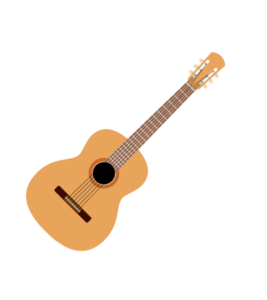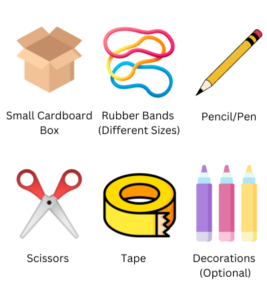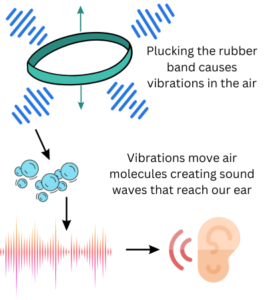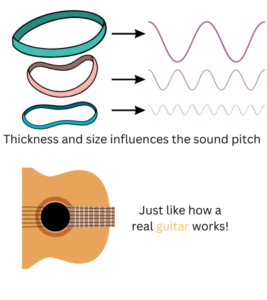
Rockin’ Rubber Band Guitar: Exploring Sound Waves!
Description: In this exciting experiment, you will create your very own rubber band “guitar” and discover how sound waves are produced. Get ready to unleash your inner musician and learn about vibrations, pitch, and volume as you strum the rubber bands and create music with science!
Scientific Principles:
- Vibrations: You will learn how vibrations are responsible for creating sound waves, which we hear as music.
- Pitch: By adjusting the tension and length of the rubber bands, you will observe how it affects the pitch or the highness and lowness of the sound.
- Volume: You will explore how the force or energy with which you pluck the rubber bands affects the volume or loudness of the sound produced.
Equipment Needed:
- Shoebox or any small cardboard box
- Rubber bands (different sizes and thicknesses)
- Pencil or pen
- Scissors
- Tape
- Optional: Decorative materials like markers, stickers, or colored paper

Difficulty Ratings: Equipment: ★★☆☆☆ (2/5) Experiment: ★★★☆☆ (3/5)
Safety Tip: Be careful when plucking the rubber bands to avoid snapping them and causing injury. Use gentle plucking motions.
Step 1: Get ready! Gather all the materials listed above and find a comfortable working space.
Step 2: Decorate your “guitar” (optional). Use markers, stickers, or colored paper to decorate your shoebox or cardboard box. Make it look like a guitar by drawing strings and adding your own artistic flair.
Step 3: Create the “strings.” a) Take a rubber band and stretch it across the top of the box. Position it over the hole you cut. b) Make sure the rubber band is tight and secure it by wrapping it around the box or using tape. c) Repeat step 3a and 3b with more rubber bands. You can use different sizes or thicknesses to create different “strings.” Add as many rubber bands as you want, just like the strings on a real guitar.
Step 4: Prepare to play! a) Hold the box firmly with one hand. b) Use your other hand to pluck the rubber bands. Gently pull and release them to create vibrations. c) Listen to the sounds produced by the vibrating rubber bands.
Step 5: Experiment with different “strings.” a) Pluck each rubber band one at a time. b) Observe and listen to how the thickness, tightness, and length of the rubber bands affect the sound they produce. c) Notice if the sound is high or low, and if it is loud or soft.
Step 6: Strum and create your own music! a) Try plucking different combinations of rubber bands simultaneously, just like strumming all the strings of a guitar. b) Experiment with different rhythms and patterns to create your own musical compositions. c) You can even try playing familiar tunes by following simple guitar tabs. Get creative and have fun!
Simple Explanation:
When you pluck the rubber bands on your homemade guitar, they vibrate or wiggle really fast. These vibrations create sound waves that travel through the air and into your ears. The different sizes and tightness of the rubber bands make different sounds, just like how different guitar strings make different sounds. It’s like magic, but it’s really science!


Detailed Explanation:
The rubber band “guitar” experiment involves the principles of vibrations and sound waves. When you pluck the rubber bands, you set them in motion, causing them to vibrate back and forth rapidly. These vibrations create sound waves, which are disturbances that travel through the air.
The pitch of the sound depends on the thickness, tightness, and length of the rubber bands. Thicker and tighter rubber bands produce lower-pitched sounds, while thinner and looser rubber bands produce higher-pitched sounds. This is because the thickness and tightness affect how fast the rubber bands vibrate, while the length determines the wavelength of the sound wave.
When the rubber bands vibrate, they push and pull on the surrounding air molecules, creating areas of high pressure and low pressure. These pressure changes form sound waves that travel through the air and reach our ears. Our ears detect these sound waves and send signals to our brain, allowing us to hear the music created by the vibrating rubber bands.
By experimenting with different combinations of rubber bands, you can explore the relationship between vibrations, pitch, and the resulting sounds. It’s a fascinating way to explore the science of sound and unleash your inner musician!



